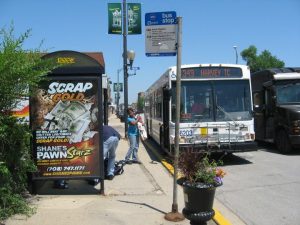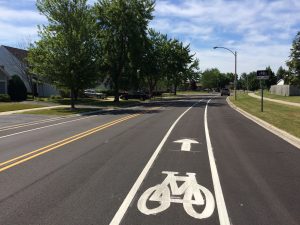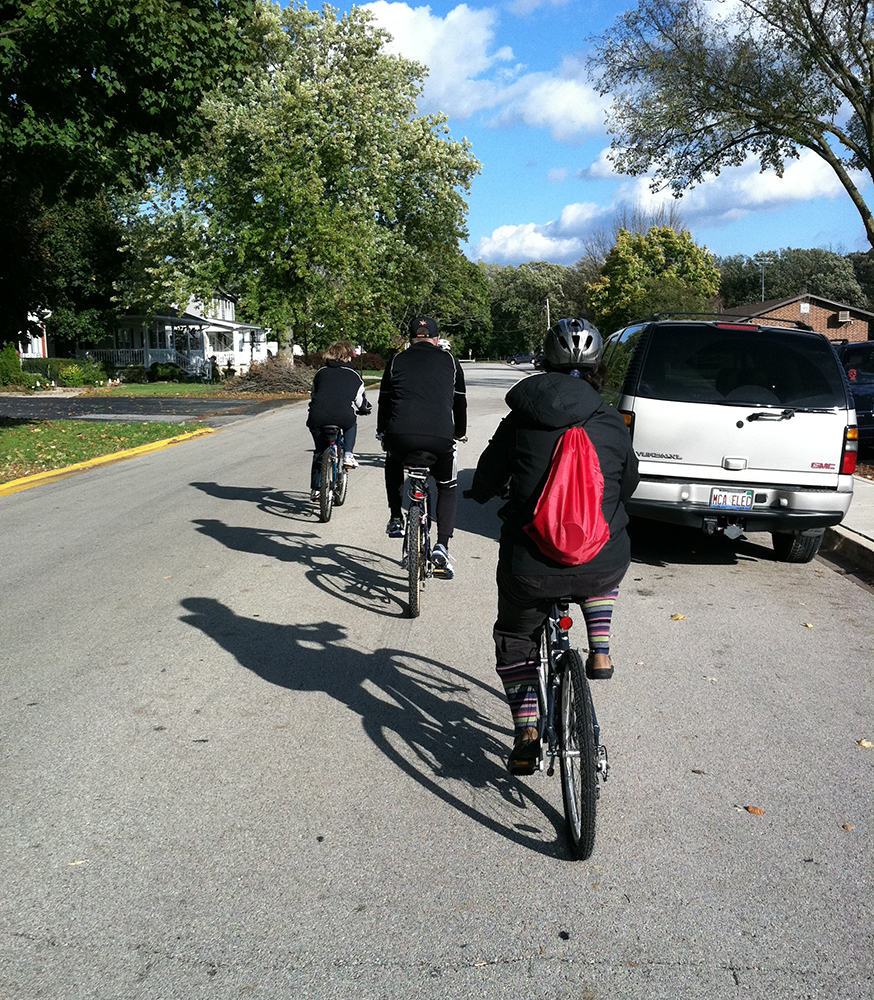The COVID-19 pandemic has changed a lot of what we perceive and know about mobility and transportation.
In recent months, Active Trans met with more than 100 stakeholders who are invested in our work. We spoke with community partners, elected officials, department of transportation and transit agency officials, municipal staff, and residents across the city and suburbs.
As part of this process, we held a series of small-group conversations and solo conversations with stakeholders in southern Cook County and Will County. Though not all encompassing, here is a glimpse of what residents in the south and southwest suburbs are experiencing.
During the course of 14 conversations, we spoke with community members, municipal staff, and elected officials representing Blue Island, Calumet City, Harvey, Joliet, Robbins, Richton Park, Summit, Cook County, and Will County (see below for the list of people we spoke with).
WALKING & BIKING
Those we spoke with from the south and southwest suburbs reported an increase in walking and biking to varying degrees since the pandemic began.
Some participants reported an increase in sidewalk and trail traffic and an overall heightened interest from the community in getting outdoors. “A lot of new families and people are out walking and biking looking for exercise or something to do,” said one person. Others observed little to no change in foot and bike traffic in their community.
 A universal sentiment, however, was that the south and southwest suburbs lack safe and accessible walking and biking infrastructure — for both transportation and recreation.
A universal sentiment, however, was that the south and southwest suburbs lack safe and accessible walking and biking infrastructure — for both transportation and recreation.
Many pointed out that this often leads to a dependence on cars, as well as health disparities, greater financial burdens, and dangerous interactions with cars for people walking and biking. According to one person, “People are fumbling to get around by foot and bike, crossing or riding on busy streets to reach destinations or access forest preserves. There’s no clear, safe, or easy way to get around.”
The groups and individuals we spoke with shared a number of transportation-related issues residents in the south and southwest suburbs commonly face:
- Lack of sidewalks and bike lanes
- Broken sidewalks and tripping hazards
- Lack of ADA accessible crossings
- Lack of lighting and concerns about personal safety
- Busy streets that are dangerous to cross
- Disconnected trail and walking/biking networks
- Transit stations that are not easily accessible by foot or bike
“These problem have always existed, and more people are realizing it during the pandemic,” said one participant.
While people offered praise for the existing network of trails and pedestrian facilities, several shared that the neighborhoods hit the hardest by COVID, namely Black and Brown communities, are the communities that most notably don’t have easy access to sidewalks or the established trail network in the Southland. “There are glaring gaps,” said one person. “When you look at health disparities, demographics, and transportation access, we’re upside down.”
Some expressed concern that the pandemic has caused a worsening financial situation for many people, making it more difficult to own and maintain a car. As a result, walking and biking serve as a vital lifeline for many people in accessing food, jobs, and other resources.
One participant noted, “This is a huge issue in our community, especially for those who are on the edge of homelessness, our senior population, and for communities who were struggling before COVID hit.”
Solutions:
- Direct more county, regional, and state funding to high need areas of the Southland region to build walking and biking networks that safely connect residents to destinations.
- Fund and implement municipal active transportation plans. For communities that cannot afford a plan, connect communities to consulting and engineering firms that offer pro-bono assistance.
- Focus efforts on Black and Brown communities and areas with health disparities within the Southland.
- Provide people and families new to biking with assistance and educational materials on how to bike safely in the suburbs.
 TRANSIT
TRANSIT
In our conversations, transit was brought up as a needed service that continues to help residents access resources and jobs in a cost effective way throughout the Southland.
Older adults, youth, low-income residents, those with disabilities, and those without access to a car were mentioned as being in most need of safe, reliable transit, especially for accessing food.
As a general concern, we heard about problems of infrequent bus and train service in the south suburbs. In recent years, budget issues have forced Pace and Metra to make service cuts in many suburban communities — and the pandemic has resulted in additional cut backs in some areas.
We also heard that service areas and bus routes often do not adequately connect residential areas to destinations: “Access is an issue. Residents have to walk a very long ways to get to a bus stop.”
Some participants shared that residents, particularly older adults, had concerns about virus transmission while riding transit. Someone from a group that serves older adults from the south suburbs said, “Many people are afraid to go anywhere right now out of health concerns. They are looking for more guidance on how they can stay safe taking the bus or train.” The participant also explained that many older adults who rely on transit to access food have no access to the internet — or limited access — to get updated transit information and learn about safety precautions.
Solutions:
- Invest in transit! Our transit system is currently stretched thin trying to serve a large suburban and rural area with a limited budget.
- Invest more regional, state, and federal dollars into the operating budget of our current system to improve service levels and connect more people to opportunity.
- Invest in new transit routes that connect low-income communities and older adults directly to essential services such as food banks, grocery stores, and medical centers.
- Take action and sign a letter to your members of Congress calling for $32 billion in COVID relief for U.S. transit agencies.
- Given that our most vulnerable populations often rely on transit, ridership numbers should not determine service levels (see our Fair Fares Chicagoland Report recommendations).
- Focus future development around existing Metra and Pace bus stations.
- Provide masks for all transit riders. Mask dispensers could be installed on buses and trains. The universal use of masks will help keep transit safe.
- Increase communication about transit, especially related to COVID cleaning procedures and best practices for staying safe (e.g. mask wearing, social distancing). Current online communication is not reaching communities most reliant on transit. Communication strategies could include sending mailers, finding key community-based organizations and informants to share resources, and posting bilingual information at popular destinations such as food pantries, libraries, and transit stops.

MUNICIPAL BUDGET & STAFF CAPACITY
Many municipalities in the south suburbs are anticipating large budget cuts and have already had to lay off staff.
Various city and village staff told us that some projects, including walking and biking improvements, are being delayed or possibly canceled as a result of budget concerns. Finding a local match for future grants was flagged as a potential issue for many communities going forward.
Solutions:
- When features like sidewalks and bike lanes are included in state roadway projects, the state should cover all costs. Currently, the Illinois Department of Transportation (IDOT) covers all portions of the roadway dedicated to cars, but asks local municipalities to cover 20 percent of the cost of walking and biking facilities.
- State and regional agencies that distribute funding should explore creative ways to help communities, especially high-need communities, invest in walking, biking, and transit improvements.
- Communities are looking for more grant administration support, opportunities to fund phase I engineering and planning studies, and ways to eliminate local match requirements for walking and biking treatments.
- More funding sources to repair broken and cracked sidewalks and fill in sidewalk gaps are needed.
- Cook County’s Invest in Cook program is an excellent funding model that other counties could replicate.
INTERSECTING ISSUES
In addition to sharing transportation concerns, participants also brought up many intersecting issues and crucial needs communities are grappling with at this time:
- Food access and insecurity
- Job loss and unemployment
- Evictions and homelessness
- Rent and mortgage pressure
- Economic disinvestment
- Storm water and flooding issues
- Internet access and bridging the digital divide
_______________________________
Thank you to those who took the time to speak with us about transportation, mobility needs, and creating a vision for a more resilient future. We look forward to advocating for and implementing that vision together:
- April Tolbert, Cook County Department of Public Health, Blue Island Robbins Neighborhood Network
- Beth Gonzales, PACE Bus
- Bill Murray, City of Calumet City
- Carol Kusman, Blue Island Robbins Neighborhood Network
- Elaine Bottomley, Will County Governmental League
- Jason Wald, PACE Bus
- Jay Readey, Southland Human Services Leadership Council
- Kendall Jackson, City of Joliet
- Kentric Benson, Blue Island Robbins Neighborhood Network
- Michael Schwarz, City of Joliet
- Nick Greifer, Village of Harvey
- Regan Stockstell, Village of Richton Park
- Mayor Sergio Rodriguez, Village of Summit
- Pete Saunders, Village of Richton Park
Be sure to read the companion blog posts featuring the North and West Suburbs and Chicago’s North Side, West Side, Southwest Side, and South Side.

